Digestion and Absorption
Alimentary Canal:

The alimentary canal begins with an anterior opening – the mouth, and it opens out posteriorly through the anus.
- The mouth leads to the ==buccal cavity== or oral cavity.
- ==The oral cavity has a number of teeth and a muscular tongue.==
- Each tooth is embedded in a ==socket of the jaw bone.==
- ==This type of attachment is called thecodont.==
- The majority of mammals including human beings form two sets of teeth during their life, ==a set of temporary milk or deciduous teeth replaced by a set of permanent or adult teeth.==
- This type of dentition is called ==diphyodont.==
- An adult human has ==32 permanent teeth== which are of four different types (Heterodont dentition), namely, incisors (I), canine (C), premolars (PM), and molars (M).
- The arrangement of teeth in each half of the upper and lower jaw in the order I, C, PM, and M is represented by a dental formula which in humans is ==2123/2123.==
- The hard chewing surface of the teeth, ==made up of enamel, helps in the mastication of food.==
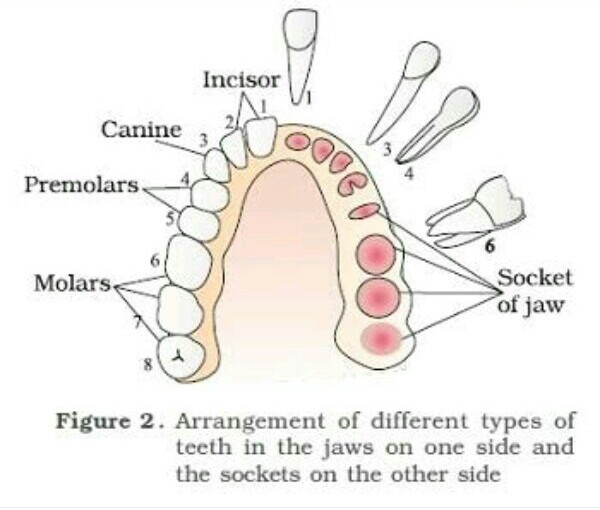
The tongue is a ==freely movable muscular organ attached to the floor of the oral cavity by the frenulum.==
- The upper surface of the tongue has small projections called ==papillae, some of which bear taste buds.==
The oral cavity leads into a ==short pharynx which serves as a common passage for food and air.==
- The ==esophagus and the trachea (windpipe) open into the pharynx.==
- A ==cartilaginous flap called epiglottis prevents the entry of food into the glottis== – opening of the windpipe – during swallowing.
- The esophagus is a thin, long tube that extends posteriorly passing through the neck, thorax, and diaphragm, and leads to a ==‘J’ shaped bag-like structure called the stomach.==
- A ==muscular sphincter (gastro-oesophageal) regulates the opening of the esophagus into the stomach.==
The stomach, located in the upper left portion of the abdominal cavity, has four major parts – ==a cardiac portion into which the esophagus opens, a fundic region, a body (main central region), and a pyloric portion== which opens into the first part of the small intestine.
The small intestine is distinguishable into three regions, a ‘==C’ shaped duodenum, a long coiled middle portion jejunum, and highly coiled ileum.==
- The opening of the stomach into the duodenum is guarded by the ==pyloric sphincter.==
- The ==ileum opens into the large intestine.==
- It consists of the ==caecum, colon, and rectum.==
- The caecum is a ==small blind sac== that hosts some symbiotic microorganisms.
- A narrow finger-like ==tubular projection, the vermiform appendix== which is a ==vestigial organ==, arises from the caecum.
- The caecum opens into the colon.
- The colon is divided into four parts – ==an ascending, a transverse, descending part, and a sigmoid colon, the descending part== opens into the rectum which opens out through the anus.
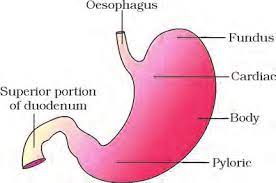
The wall of the alimentary canal from the esophagus to the rectum possesses four layers namely ==serosa, muscularis, submucosa, and mucosa.==
- Serosa is the outermost layer and is made up of a ==thin mesothelium (epithelium of visceral organs)== with some connective tissues.
- Muscularis is formed by smooth muscles usually arranged into an ==inner circular and an outer longitudinal layer.==
- An oblique muscle layer may be present in some regions.
- The ==submucosal layer is formed of loose connective tissues containing nerves, blood, and lymph vessels==.
- In the duodenum, glands are also present in the sub-mucosa.
- The innermost layer lining the ==lumen of the alimentary canal is the== ==mucosa.==
- This layer forms irregular folds (rugae) in the stomach and ==small finger-like foldings called villi== in the small intestine.
- The cells lining the villi produce numerous microscopic projections called ==microvilli giving a brush border appearance.==
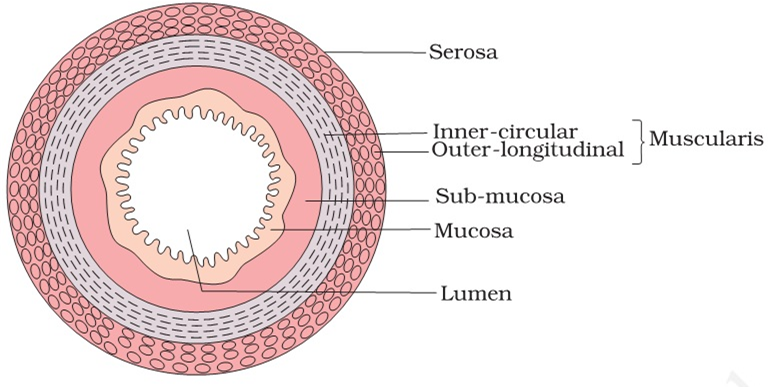
These modifications increase the surface area enormously.
- Villi are supplied with a ==network of capillaries and a large lymph vessel called the lacteal.==
- The mucosal epithelium has ==goblet cells that secrete mucus== that help in lubrication.
- Mucosa also forms ==glands in the stomach (gastric glands) and crypts in between the bases of villi in the intestine (crypts of Lieberkuhn).==
All four layers show modifications in different parts of the alimentary canal.
Digestive Glands:
The digestive glands associated with the alimentary canal include the salivary glands, the liver, and the pancreas.
- Saliva is mainly produced by three pairs of ==salivary glands, the parotids (cheek), the submaxillary/sub-mandibular (lower jaw), and the sub-linguals (below the tongue).==
- These glands situated just outside the buccal cavity secrete salivary juice into the buccal cavity.
- The ==liver is the largest gland of the body== weighing about 1.2 to 1.5 kg in an adult human.
- It is situated in the abdominal cavity, just below the diaphragm, and has two lobes.
- ==The hepatic lobules are the structural and functional units of the liver== containing hepatic cells arranged in the form of cords.
- Each lobule is covered by a thin connective tissue sheath called ==the Glisson’s capsule.==
- The bile secreted by the hepatic cells passes through the hepatic ducts and is stored and concentrated in a thin muscular sac called the ==gall bladder.==
- The duct of the gall bladder ==(cystic duct)== along with the hepatic duct from the liver forms the common bile duct.
- The ==bile duct and the pancreatic duct open together into the duodenum as the common hepato-pancreatic duct== which is guarded by a sphincter called the ==sphincter of Oddi.==
- The pancreas is a compound (both exocrine and endocrine) elongated organ situated between ==the limbs of the ‘C’ shaped duodenum.==
- The exocrine portion secretes an alkaline pancreatic juice containing enzymes and the endocrine portion secretes hormones, ==insulin, and glucagon.==
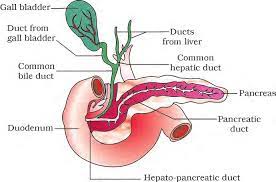
Digestion of Food:
The process of digestion is accomplished by mechanical and chemical processes.
- The buccal cavity performs two major functions, ==mastication of food and facilitation of swallowing.==
- The teeth and the tongue with the help of saliva ==masticate and mix up the food== thoroughly.
- Mucus in saliva helps in ==lubricating and adhering the masticated food particles into a bolus.==
- The bolus is then conveyed into the pharynx and then into the esophagus by ==swallowing or deglutition.==
- The bolus further passes down through the esophagus by successive ==waves of muscular contractions called peristalsis.==
- The gastro-oesophageal sphincter controls the passage of food into the stomach.
- The saliva secreted into the oral cavity contains electrolytes and enzymes, salivary amylase, and lysozyme.
- The chemical process of digestion is initiated in the oral cavity by the hydrolytic action of the carbohydrate-splitting enzyme, salivary amylase.
- About ==30 percent of starch is hydrolyzed here by this enzyme (optimum pH 6.8) into a disaccharide – maltose.==
- ==Lysozyme present in saliva acts as an antibacterial agent that prevents infections.==
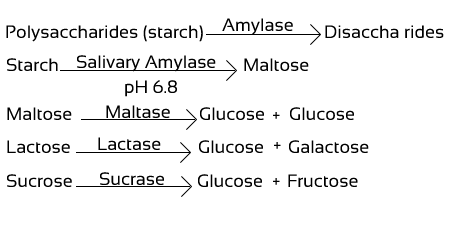
The mucosa of the stomach has gastric glands.
Gastric glands have three major types of cells namely -
- Mucus neck cells that secrete mucus
- ==Peptic or chief cells== ==which secrete the proenzyme pepsinogen==
- ==Parietal or oxyntic cells== ==secrete HCl and intrinsic factors (factor essential for the absorption of== ==vitamin B12====).==
The stomach stores the food for 4-5 hours.
- The food mixes thoroughly with the acidic gastric juice of the stomach by the churning movements of its muscular wall and is called the ==chyme.==
- The proenzyme pepsinogen, on exposure to hydrochloric acid, gets converted into the active enzyme pepsin, ==the proteolytic enzyme of the stomach.==
- ==Pepsin converts proteins into proteoses and peptones (peptides).==
- The mucus and bicarbonates present in gastric juice play an important role in ==lubrication and protection of the mucosal epithelium== from excoriation by highly concentrated hydrochloric acid.
- HCl provides the acidic pH (pH 1.8) ==optimal for pepsins==.
- ==Rennin== ==is a proteolytic enzyme found in the gastric juice of infants which helps in the digestion of milk proteins.==
- Small amounts of lipases are also secreted by gastric glands.
- Various types of movements are generated by the muscularis layer of the small intestine.
- These movements help in a thorough mixing up of the food with various secretions in the intestine and thereby ==facilitate digestion.==
- The ==bile, pancreatic juice, and intestinal juice== are the secretions released into the small intestine.
- Pancreatic juice and bile are released through the hepato-pancreatic duct.
- The pancreatic juice contains inactive enzymes – ==trypsinogen, chymotrypsinogen, procarboxypeptidases, amylases, lipases, and nucleases.==
- ==Trypsinogen is activated by an enzyme, enterokinase==, secreted by the intestinal mucosa into active trypsin, which in turn activates the other enzymes in the pancreatic juice.
- The bile released into the duodenum contains bile pigments (==bilirubin and biliverdin==), ==bile salts, cholesterol, and phospholipids but no enzymes.==
- Bile helps ==in the emulsification of fats,== i.e., breaking down the fats into very small micelles.
- Bile also ==activates lipases.==
- The intestinal mucosal epithelium has goblet cells that secrete mucus.
- The secretions of the ==brush border cells of the mucosa== along with the secretions of the goblet cells constitute the ==intestinal juice or succus entericus.==
- This juice contains a variety of enzymes like disaccharidases (e.g., maltase), dipeptidases, lipases, nucleosidases, etc.
- The mucus along with the bicarbonates from the pancreas ==protects the intestinal mucosa== from acid as well as provides an alkaline medium (pH 7.8) for enzymatic activities.
- ==Sub-mucosal glands (Brunner’s glands)== also help in this.

The breakdown of biomacromolecules occurs in the duodenum region of the small intestine.
- The simple substances thus formed are absorbed in the ==jejunum and ileum== regions of the small intestine.
- The undigested and unabsorbed substances are passed on to the large intestine.
- No significant digestive activity occurs in the large intestine.
The functions of the large intestine are
- ==Absorption of some water, minerals, and certain drugs.==
- Secretion of mucus which helps in adhering the waste (undigested) particles together and ==lubricating== it for an easy passage.
- The undigested, unabsorbed substances called feces enter the caecum of the large intestine through the ileocaecal valve, which ==prevents the backflow of the fecal matter.==
- It is temporarily stored in the rectum till defecation.
The activities of the gastrointestinal tract are under neural and hormonal control for proper coordination of different parts.
- The sight, smell, and/or presence of food in the oral cavity can stimulate the secretion of saliva.
- Gastric and intestinal secretions are also, similarly, stimulated by neural signals.
- The muscular activities of different parts of the alimentary canal can also be moderated by neural mechanisms, both local and through CNS.
Hormonal control of the secretion of digestive juices is carried out by local hormones produced by the gastric and intestinal mucosa.
Absorption of Digested Products:
Absorption is the process by which the end products of digestion pass through the intestinal mucosa into the blood or lymph.
It is carried out by passive, active, or facilitated transport mechanisms.
- Small amounts of ==monosaccharides like glucose, and amino acids, and some electrolytes like chloride ions== are generally absorbed by simple diffusion.
- The passage of these substances into the blood depends upon the ==concentration gradients.==
However, some substances like glucose and amino acids are absorbed with the help of carrier proteins.
- This mechanism is called ==facilitated transport.==
- The transport of water depends upon the ==osmotic gradient.==
- Active transport occurs against the concentration gradient and hence requires energy.
- Various nutrients like amino acids, monosaccharides like ==glucose, and electrolytes like Na+== are absorbed into the blood by this mechanism.
==Fatty acids and glycerol being insoluble==, cannot be absorbed into the blood.
- They are first incorporated into small droplets called ==micelles== which move into the intestinal mucosa.
- They are re-formed into very small ==protein-coated fat globules called the chylomicrons== which are transported into the lymph vessels (lacteals) in the villi.
- These lymph vessels ultimately release the absorbed substances into the bloodstream.
- Absorption of substances takes place in different parts of the alimentary canal, like the mouth, stomach, small intestine, and large intestine.
However, maximum absorption occurs in the small intestine.

The absorbed substances finally reach the tissues which utilize them for their activities.
- This process is called ==assimilation.==
- The digestive wastes, solidified into coherent faeces in the rectum initiate a neural reflex causing an urge or desire for its removal.
The egestion of faeces to the outside through the anal opening (defecation) is a voluntary process and is carried out by a mass peristaltic movement.
Disorders of Digestive System:
- The inflammation of the intestinal tract is the most common ailment due to bacterial or viral infections.
- The infections are also caused by the parasites of the intestine like tapeworm, roundworm, threadworm, hookworm, pinworm, etc.
Jaundice:
- The liver is affected, and skin and eyes turn yellow due to the deposit of bile pigments.
Vomiting:
- It is the ejection of stomach contents through the mouth.
- This reflex action is controlled by the vomiting center in the medulla.
- A feeling of nausea precedes vomiting.
Diarrhea:
- The abnormal frequency of bowel movement and increased liquidity of the faecal discharge is known as diarrhea.
- It reduces the absorption of food.
Constipation:
- In constipation, the feces are retained within the colon as the bowel movements occur irregularly.
Indigestion:
- In this condition, the food is not properly digested leading to a feeling of fullness.
- The causes of indigestion are inadequate enzyme secretion, anxiety, food poisoning, overeating, and spicy food.
Protein-energy Malnutrition:
- Dietary deficiencies in proteins and total food calories are widespread in many underdeveloped countries of ==South and Southeast Asia, South America, and West and Central Africa.==
- This may affect large sections of the population during drought, famine, and political turmoil.
- This happened in ==Bangladesh during the liberation war and in Ethiopia during the severe drought in the mid-eighties.==
- PEM affects infants and children to produce ==Marasmus and Kwashiorkor.==
- ==Marasmus is produced by a simultaneous deficiency of proteins and calories.==
- It is found in ==infants less than a year== in age if a ==mother’s milk is replaced== too early by other foods which are poor in both ==proteins and caloric valu==e.
- This often happens if the ==mother has second pregnancy or childbirth== when the older infant is still too young.
- In Marasmus, protein deficiency ==impairs the growth and replacement of tissue proteins; extreme emaciation of the body and thinning of limbs results, in the skin becoming dry, thin, and wrinkled.==
- Growth rate and body weight decline considerably.
- Even growth and development of the brain and mental faculties are impaired.
- Kwashiorkor is produced by ==protein deficiency unaccompanied by calorie deficiency.==
- It results from the ==replacement of a mother’s milk with a high-calorie low protein diet== in a child more than one year in age.
- Like marasmus, kwashiorkor shows ==wasting of muscles, thinning of limbs, failure of growth, and brain development.==
- But unlike marasmus, some fat is still left under the skin; moreover, extensive edema and swelling of body parts are seen